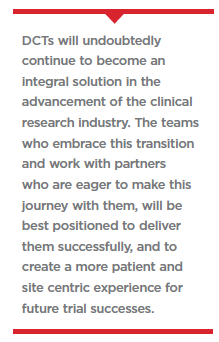 Anyone who has ever had a child with a suspicious sore throat or rash has considered the convenience of getting a diagnosis over the phone. But they know that as soon as they call the doctor’s office, they are going to have to get in the car and drive to a face-to-face appointment. Until now.
Anyone who has ever had a child with a suspicious sore throat or rash has considered the convenience of getting a diagnosis over the phone. But they know that as soon as they call the doctor’s office, they are going to have to get in the car and drive to a face-to-face appointment. Until now.
COVID-19 forced healthcare providers and the research industry to rethink how they engage with patients and to make virtualization a normal part of the healthcare paradigm. Now that patients have experienced the ease of digital healthcare, they may not go back.
The Pandemic as a Driver for Decentralized Trials
When the pandemic forced patients to stay home and trial sites to temporarily close, sponsors had no choice but to embrace elements of decentralized clinical trials (DCTs), including virtual visits, home healthcare, and the use of direct to patient investigational product delivery services to ensure trial continuity. The rush to shift to virtual happened almost overnight, with sponsors, CROs, vendors, sites, and regulators doing everything they could to adapt to the sudden change in research environment.
The commitment by the research community to continue clinical trial progress was admirable. Now, these groups have an opportunity to decide whether they will continue use of DCT strategies proactively post pandemic and how they can leverage them to enhance site and patient centricity and future adaptability.
Most industry experts agree that hybrid and DCT models will be the new normal for clinical trials. A survey conducted in late 2020 found 67% of sponsors plan to use DCTs in the future.
For some, this shift from pre-pandemic opinions can be viewed as a positive outcome of the rapid disruption. Broad application of patient and site centricity from the forced adoption of virtual elements has caused late DCT adopters to recognize virtualization can help increase patient engagement, reduce barriers to participation, and create a more adaptable trial environment. However, it requires a new approach to trial strategy and planning.
 According to an Oracle survey, due to the pandemic, 45% of sponsors had amended protocols, and 41% had paused protocols. At the present time, sponsors have time to plan their new trials with the experience and strategies applied to their pandemic-effected programs, lending opportunity to innovation, time and money savings, and increased engagement.
According to an Oracle survey, due to the pandemic, 45% of sponsors had amended protocols, and 41% had paused protocols. At the present time, sponsors have time to plan their new trials with the experience and strategies applied to their pandemic-effected programs, lending opportunity to innovation, time and money savings, and increased engagement.
Planning Hybrid DCTs: Making the Most of it Without Historical Data
Trial strategy and planning is often based on experience. Sponsors and CROs select sites, establish budget estimates, and establish timelines using prior trials as their roadmap. But for sponsors who want to integrate elements of DCTs, there may be limited history and hard facts to rely upon. Although the clinical research industry may be viewed as risk-averse, the idea of adoption based on trends and not fact can be daunting for clinical teams who are often given a budget to work within before feasibility of a protocol can be assessed.
While data from trials conducted during the pandemic will offer evidence and trends into the issues that need to be considered when adopting DCTs, the data is early, and is based on rapid decisions driven by the need to demonstrate trial results and adapt to the environmental changes. The industry will need to develop a meaningful history of decentralized clinical trials to leverage lessons learned for future planning. In the meantime, enhanced cross-functional, provider, and site collaboration and transparency is needed to optimize strategy and implementation of DCTs.
Each stakeholder in the trial environment will have a unique perspective on how to build a successful hybrid DCT. Gathering feedback during planning will help in making the right decisions early and avoid costly delays, missed deadlines, and amended protocols.
Five Key Questions to Ask Your Clinical Research Partner:
1. What components of this protocol work in a hybrid or decentralized model?
All stakeholders contribute to embracing the hybrid and DCT model for a protocol, they can question the status quo, and adapt the criteria/requirements to maximize results. The adaptations may have implications across the trial design, the way sites or patients interact, etc. Therefore, it is key to ask these questions early in the process, and to extend these questions to all potential partners early in the strategy planning process.
Every site visit needs to be assessed to determine what can be done remotely. Patients may not be as willing to commute to a visit to answer questions, complete forms, or to assess routine vital signs that could be obtained via ePRO or wearable. All providers and sponsors want to attract and retain trial participants; we need to be cognizant of the shifting tolerance for face-to-face visits.
For example, if a routine dosing is needed, rather than requiring patients visit the site, consider the feasibility for patients to self-administer. Moving to self-administration could make some patients hesitant to enroll. This realization may prompt additional proactive planning to engage home health to oversee or support self-dosing or to provide additional patient training via mobile applications to ease concerns.
2. Will sites embrace protocol conduct in a hybrid/DCT model?
Many DCTs still require high-performing sites as successful hybrid trials need sites to be fully on-board with the overall strategy. Some strong enrolling sites that have been relied on for past trials may not be eager to make this shift, asking early probing questions and communicating transparently is key to strategy development.
There are many reasons a site may embrace or reject hybrid trials, including IT infrastructure, approval processes, training requirements, and level of interest from leaders and staff. Sponsors and CROs need to be transparent in conversations, seeking a balance between evaluating a site’s true interest in conducting hybrid/DCTs, educating them about what the trial will involve, what training and support they can expect to receive, and how it will change the way they have worked in the past. Sites also have a role in the transparent discussions. A site’s ability and experience conducting hybrid/DCTs versus its willingness to learn and conduct should be clearly communicated.
Sites face greater disruption and a steep learning curve compared with other stakeholders in this environment. For example, sites must learn and implement various new technologies and processes implemented by sponsors across multiple protocols. Parties selecting the sites and planning executional components need to be cognizant of that, and open to working with sites who demonstrate a desire to embrace this change.
3. How will CRO and vendors support and optimize the hybrid/DCT model?
The shift to a hybrid or DCT model requires a change in mindset, culture, and operations. One strategy to minimize gaps is to learn from partners and vendors, sharing successes and barriers experienced during the pandemic can optimize your own strategy. To continue the momentum that the industry experienced migrating to hybrid and DCT and to make it a permanent part of the way we conduct research, partners need to embrace the same vision and work together to find the best path forward.
Evaluating and selecting providers who can successfully support a hybrid model/DCT requires more than asking if they can do remote monitoring or have experience with telehealth platforms. Sponsors should talk to CROs/vendors about their long-term innovation plans, how DCTs and hybrid trials fit into their roadmaps, and how it is changing the way they work. These types of trials may require redefining traditional responsibilities, new workflows, and new working relationships. Having collaborative conversations about how these new projects will operate, what they will cost, experience required, technology usage, and access to peripheral services, is the best way to ensure a successful outcome.
4. How will data be reviewed and utilized to make faster strategic decisions?
One of the great benefits of a DCT is the rapid access to patient data. When the trial involves electronic diaries, wearable devices, and other digital reporting tools, data begins flowing the moment a patient is enrolled, giving immediate access to digital data on day one.
Some trials still experience a lag in accessing data based on what is gathered at site visits and translated into trial databases. Data review plans or assessments may need to be re-defined. What if a risk threshold is met or early trends arise; how will the data be acted upon? While many traditional data and monitoring plans address these items, the actions taken may be different in a DCT/hybrid model.
Early access to data, and the potential to collect thousands of datapoints from wearable devices, may change how a patient’s condition is monitored, how adverse events are detected, and identify outcome trends that can support go/no-go decision making.
Access to more data — and faster — is a great benefit. But all parties need to have processes in place to review and respond to this data to make it worthwhile.
5. How will the benefits of a hybrid or decentralized trial be promoted to attract and retain patients?
Many of the benefits of DCTs have a direct positive impact on patients. Telehealth visits, electronic diaries, wearable devices, and home delivery of investigational product and care services transform the patient experience, making it a seamless part of their daily routine. The decentralized approach lowers the burden of participation and makes trials a realistic care option for patients facing diseases with many or few treatment options.
These benefits are likely to positively affect enrollment and are shown to increase subject retention — if they are communicated effectively. That requires consistent messages that acknowledge the time commitment that patients make when taking part in a trial. Throughout the pandemic, efforts to create a COVID-19 vaccine caused the general public to become more educated about clinical trials and opportunities to participate. They read daily articles about COVID-19 trials, saw firsthand how a product goes through the development and review process, etc. This knowledge base should be leveraged given this heightened awareness to clinical trials and the potential for positive outcomes.
Looking Ahead: Decentralization Will Be a Permanent Fixture
DCTs will undoubtedly continue to become an integral solution in the advancement of the clinical research industry. The teams who embrace this transition and work with partners who are eager to make this journey with them, will be best positioned to deliver them successfully, and to create a more patient- and site-centric experience for future trial successes.(PV)
Advanced Clinical is a global clinical research services organization that provides CRO, FSP, strategic resourcing, and quality and validation services for biopharmaceuticaland medical device organizations.
For more information, visit advancedclinical.com.

















